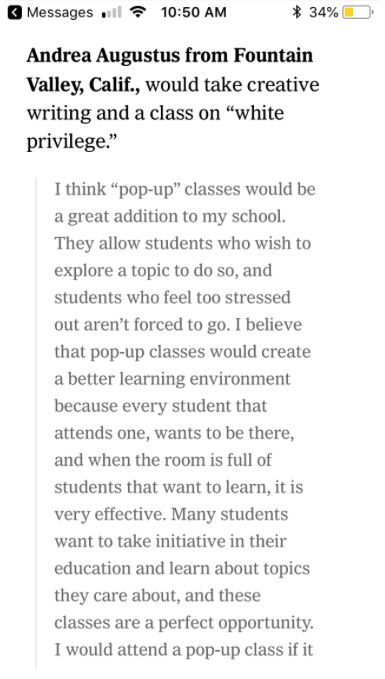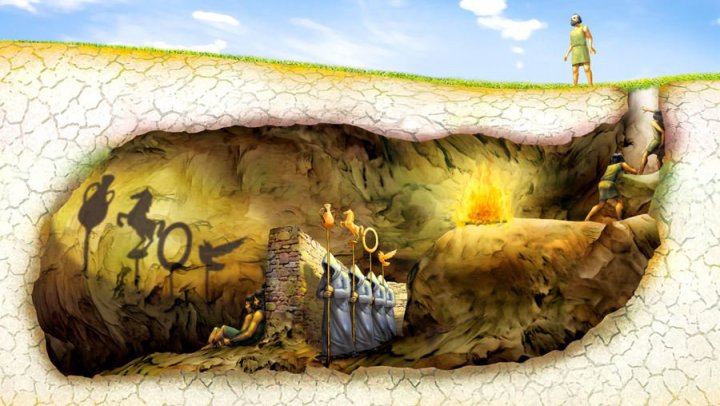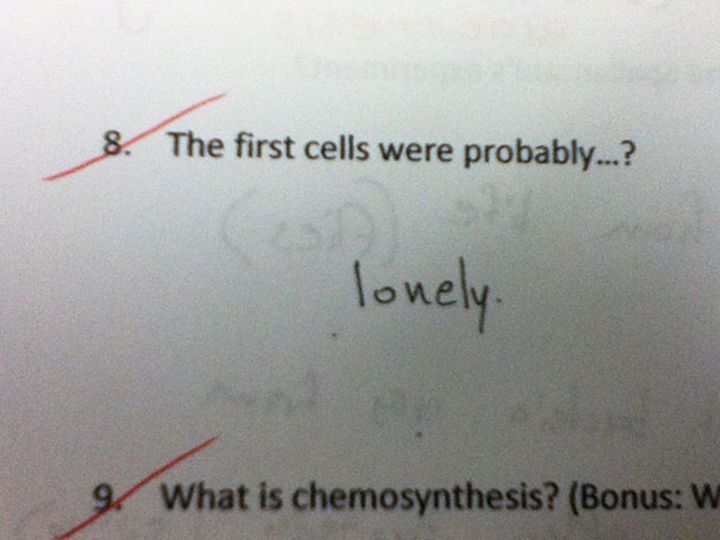When Mr. Ziebarth instruced the class to create a Twitter and Instagram account for this class, I groaned internally. I have never been very tech-savvy, and the thought of taking up multiple social media platforms seemed like an exhausting waste of time. Who would even see my blog anyway?
Initially I hated posting on my blog. I didn’t like putting things on my Twitter and Instagram. But then something happened. I started getting comments on my blog posts. These comments were insightful opinions from my fellow classmates. These comments argued or agreed with my ideas, and they offered new perspectives I hadn’t thought of. These comments made me feel like my blog was worthwhile after all.

In the picture above, a fellow student from my second period class commented on my post, “Why Do Students Fail”, in which I explored how the pressures of learning in a classroom setting can demotivate students. When I wrote it, I did not expect anyone but perhaps Mr. Ziebarth to read it. Thus, I was pleasantly surprised to see that someone did read it, and she liked it enough to add her own input.
In her comment, Natasha offered new insight into my topic by challenging my position instead of simply agreeing with me. She told me to see things through the teacher’s perspective, because I had only been writing in the perspective of the student, or me. With her comment, Nastasha encouraged me to look outside my own perspective and I have tried to implement that into other pieces of writing I have done.
Mr. Ziebarth offered extra participation credit for commenting on blog posts, so I jumped right in. To be honest, I really needed the extra credit. I navigated through the class collection of Twitter accounts and blogs and read every article that intrigued me. And you know what? I actually learned something. I learned that Lauren from fourth period and I have similar views about our modern society and how people justify immorality by calling it freedom and love. In her article, “Who Are You to Judge?”, Lauren opened my eyes and connected ideas that I never could have tied together without reading her perspective. Now that I read her article I feel more able to express my feeling on the subject.

And that is exactly what sharing ideas is! It is expressing your original thoughts and putting them out there for people to read. And as people read and comment and share that is how great ideas get formulated.
That is one of the most important things I learned this semester. These social media platforms that I initially hated were designed to help me project my thoughts and to give people access to them.
Another great aspect of social media was the ability to comment on posts. For extra credit, I read an article published by the New York Times, and after thinking about it, posted a comment. The New York Times later published my comment, among other kids’ comments, so people could read not only what the New York Times writers had to say, but what kids from around the country thought about the topics. This gave me great confidence as a writer to be published in the New York Times. 
Simply by commenting on a website, I was able to get my thoughts published so anyone can read them.
Sharing thoughts and new ideas through articles is a great way to connect with people, and it is how many ideas on politics and world issues are debated and shared today. Articles in newspapers (physical and online), are the most common ways to distribute information and debate ideas. But there are other means by which people can spread ideas.
My dance choreography teacher always told us to choose a topic we feel strongly about, and create movement based off of that. She said every dance is an idea, a story, a journey. Through taking the choreography class this year, I found that dance is a lot more than just steps.
Dance is communication. It is a language. But unlike other languages, it doesn’t have a direct translation to English. There is no dictionary outlining a limited vocabulary for dance, because dance vocabulary is endless, and varies from person to person. There is no way to explain the message dance gives, because it has to be watched and experienced to be understood.
Although dance is such a huge part of my life, I never thought it would be applicable in the classroom. The classroom setting just never seemed like the right place to dance out my ideas. So when Mr. Ziebarth asked why I didn’t use dance to represent my question exploration project, I didn’t know what to say. I guess I didn’t think they were connected? I’ve learned since then, that dance and English are very similar.
This revelation hit me the hardest during a tap choreography adjudication. The adjudication began with each piece performing and then the panel of judges giving comments and corrections. This in itself is similar to how we peer edit papers in class.
For this adjudication I submitted a tap piece that was performed by APA’s Tap Ensemble. I created this piece to represent how a soldier who was drafted into the army would feel and the range of emotions the soldier would go through in their journey. A link to the video of my piece is here.
https://drive.google.com/file/d/1Q-Bq5zPI3Bl_LcTiAPxeV05H8DuVJGeX/view?usp=sharing
World renowned tap choreographer Linda Sohl-Ellison commented on certain components of my piece and how they added to the overall message I was trying to convey. A video of her adjudication is here.
https://drive.google.com/open?id=1wOMD46wDFpSbOoQSgGOS_Ch_MBjmu84o
These elements that Sohl-Ellison points out, are similar to telling a story through English and Dance.
Concept: “I thought this was a great effort…at combining a concept, really being connected to your concept, not just in a superficial way”
In both dance and English writing, there is a concept. For my dance piece, the concept was a soldier’s feelings after getting drafted. When you construct a piece, you have to stay with the concept and every section of the dance has to develop the around concept. Similarly, with writing, you have to have a thesis that you stick with and you develop ideas around the thesis.
Title: “I’m always telling my choreography students to look at the title, don’t just arbitrarily slap a title on this piece. The audience should look at that title, and not necessarily know the whole story. The story will unfold, and it needs to have an openness as to what the story is as the piece unfolds.”
In both writing and dance, the title must intrigue the audience, but not give it all away.
Details: “Your choice of costuming was effective, the footwork, the formations, the formality, the reverence, the relationships. We had time to take in the lyrics, there was space”.
All the details in a dance must come together to further the concept. Likewise, the details in English must come together for character development, or to further the plot.
Connections to other works: “Connection to the music was excellent, to the point where the lyrics said raise your hand, there was a subtle arm movement. But it wasn’t pounding us over the head with matchy-matchy gesture to lyrics. Just a little reference”.
In English, when you are writing a synthesis essay, you can’t simply summarize the references. You have to use them to develop your own piece, not recreate them and make a copy. It is the same in dance. When using music with lyrics, you cannot mime the actions the music is talking about. You have to use the music to create your own story, not copy the story the singer is telling.
Tone: “You could work with your dancers maybe a little bit more on the tone, how to perform it. It’s hard because it’s not a smiley tap piece. What is that facial expression, what are we feeling as a regiment?”
Tone in writing is important, and must be clear. Tone can be created using specific language, imagery, and characterization.
After exploring with the similarities between dance and writing, I found that another thing that is the same in both disciplines is improvisation. When I improvise in dance, I have no plan, no outline, no idea of what I am doing. I simply listen to the music, (or if it’s a cappella I listen to the rhythm in my head), and move the way I feel. I don’t even know what I am doing, I just feel. After, I have no memory of how I just performed and I am shocked when I watch a video of my performance.
Like dance, there is improv writing that we have done in Mr. Ziebarth’s class this year. He said to write without any kind of outline and not take your pencil off the paper until the time is up. This is similar to dance improv because you can’t stop moving. Also, improvising in writing happens as an instinct, you listen to the voice in your head and you write it without thinking. After, you don’t even know what you have just written until you reread it.
Both kinds of improvisation allow you to see inside yourself. When you improvise in dance. You move in a way you didn’t you could because you were trapped within the boundaries of set choreography. Likewise, when you improvise writing, thoughts come out that you never knew were in your head.
By using what I learned from improvising in dance and writing, I have been able to write faster essays and pull my thoughts together quicker for the AP test.
The most important thing I learned this year, is that everything is connected. Dance is an art but also a language, and English is a language but also an art. The things we learn in school connect to the things we learn outside of school. I also learned how to share my ideas not only through my writing, but also through dance. Mr. Ziebarth taught me that you can learn from anything, anywhere, and I’m glad I got to be in a class that encourages learning in whatever way suits you.






 A clear example of this is demonstrated here. Because the student did not write exactly what the teacher was hoping they learned, she got punished. Not only did the student receive a bad score, but she is taught that creativity is unaccepted. This bright student did learn from school, she just didn’t learn what the teacher wanted. This form of classroom learning- the choke down facts and hold it down long enough for the test to come kind of learning-is the reason why students are losing interest.
A clear example of this is demonstrated here. Because the student did not write exactly what the teacher was hoping they learned, she got punished. Not only did the student receive a bad score, but she is taught that creativity is unaccepted. This bright student did learn from school, she just didn’t learn what the teacher wanted. This form of classroom learning- the choke down facts and hold it down long enough for the test to come kind of learning-is the reason why students are losing interest.  The Gallop Student Poll had a survey taken to see the trend in student engagement in school. It was found that students became less engaged as they progressed through school.
The Gallop Student Poll had a survey taken to see the trend in student engagement in school. It was found that students became less engaged as they progressed through school.